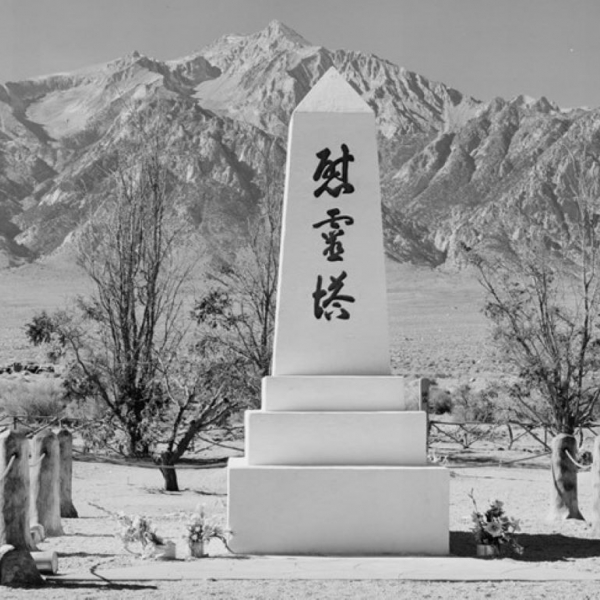Virtually none of the media coverage trickling out of Ferguson has documented the ongoing acts of commemoration in the community. The city is now said to be "moving on," "healing," or at least "rebuilding." While local commemorative activities have proliferated in recent weeks -- painted messages on plywood boards covering local storefronts, "RIP Mike Brown" t-shirts for sale under a tent at the Celebrity Restaurant, mounds of flowers, notes and teddy bears left on the spot on Canfield Drive where Brown's body lay, and most recently, a string ribbons affixed to the chain-link fence around the burned-out QuikTrip -- the national press has shown little interest in them.
This is something of a surprise given the fascination Americans typically show for public acts of commemoration. Temporary memorials in Oklahoma City, Columbine, Aurora, Sandy Hook, and other sites of tragedy have garnered front-page coverage and lead to nation-wide participation in commemoration work, for example. In these cases, local outpourings merged with the mounds of paper cranes and hand-made American flags sent by schoolchildren and the flowers and handmade tribute objects delivered by well-wishers. While these activities dwindled within a few months, the expressions of unity in commemoration shaped political views on the tragedies themselves and more persistent forms of public memory. They even made their way into permanent memorial designs.
To be sure, commemorative acts in Ferguson have served, and continue to serve, many local needs. The mounds of flowers on Canfield still invite small-scale political gatherings and acts of pilgrimage, and the QT ribbons receive honks and stares from passersby, some of whom are moved to get out and take photographs. Both of these memorials quietly humanize Michael Brown and the grief, loss and recovery of the Ferguson community. Their modest scale and (at least from a distance) seemingly benign messages seem to have placed them in a category of ephemeral tribute. And yet, they continue to call public attention to the sites of trauma they mark.
The ribbons are especially noteworthy, for they represent the first public commemoration on the QuikTrip fence since the convenience store was destroyed and the site contained. Most are between 14-20 inches in length, pastel in color, and made of weather-resistant materials -- silk, wool, synthetic fibers, clear plastic. They flutter in the wind and rain, and offer a splash of color to a site that now, thanks to clean-up and enforced abandonment, reads more as a crime scene than a locus of political action. Organizers have hung them vertically, each one tied to a string, groups of them arranged like swags of garland on a bannister. There is a subtle echo between the gentle U-shape of these swags and the sagging roofline of the QT that can be seen in the background. Such uncanny effects are not uncommon at sites of commemoration, where traces of disorder and trauma mingle with signs of new life and hope. The sites gain much of their power from this interplay.
The QuikTrip ribbons are part of a larger "Ribbons of Hope" project launched on August 23 and installed on the fencing at two locations -- the QT and the Ferguson Farmer's Market -- in recent days. The project appears to be the only officially sanctioned act of commemoration in Ferguson to this point. Visitors can read about the project on a placard mounted with the ribbons that names local sponsors, including several arts organizations and the Ferguson Youth Initiative, members of whom worked to collect the ribbons during a recent Saturday gathering at the Farmer's Market. The project website imagines the ribbon project as a kind of "safe space" in which the community can "reflect, connect, commune and exchange dialogue. OUR HOPE is to encourage community connection, creative collaboration, expression & dialogue of HOPE, wishes, dreams and prayers as the community moves forward." It is intended to "nurture and strengthen community spirit and build bridges toward the future of Ferguson." The decision to place the ribbons at these two locations suggests an effort to bridge the divide between "safe" and "unsafe," between wealthier and poorer neighborhoods, and also between black and white Ferguson.
The project deploys a rhetoric of unification and hope, and draws upon established routines of collaborative commemoration work to do so. The routines include the leaving of evocative objects in symbolic locations (yellow ribbons tied around oak trees in the yards of families missing soldiers at war, flags and peace offerings left on the fence around New York City's Ground Zero), the carrying of commemorative objects from place to place (red AIDS awareness or pink Race for the Cure ribbons one wears on one's clothes, one's car bumper, etc.), and the use of symbols of hope at sites of loss (such as chains of origami cranes). Organizers hope to collect many more ribbons in weeks to come, and to suggest, through their sheer proliferation, the scale of nation-wide concern for the events in Ferguson. For the moment, however, the ribbon displays at both sites appear small and well-mannered; they do not suggest waves of grief or shared loss (as did the massive mounds of flowers that appeared on the deceased students' cars at Columbine High School) so much as individual acts of tribute strung together into orderly, festive arrays.
The ribbons all bear hand-written messages that are meant to be read up-close, as personal messages to the "Ferg" community. Some are from self-identified Ferguson residents and members of nearby municipalities, while others are from outside the region. Many have been offered by young people, and most have uplifting messages aimed at a community that is understood to be divided and suffering: "Be Strong [hand-drawn heart and peace symbol] Love God," "UNITY in Ferguson," "For every one bad, for every one evil, there are 100 GOOD!," Kill the Violence, NOT each other!!!," "You intended to harm us, but God intended it all for Good," "Peace, Love, Hugs & no hate in Ferg!!:," etc. These self-consciously personalized tributes are clearly in dialogue with the more general political slogans that first appeared at the QT as graffiti, protest signage, and physical acts of resistance (singing, chanting, "don't shoot" arm-motions, etc.). They are less-caustic and provocative, evidencing concern that the community move toward more "positive" forms of public dialogue.
But not all the messages have this optimistic orientation; some voice shared (not personalized) frustration or acknowledge the suffering of victims. Others call for political change: "Let Justice Roll Down," says one, adding that to "know justice [is to] know peace." "More construction, less crime forever!," says another. "You can win the battle but lose the war," says a third. While many make religious statements, a good number of which are blatantly Christian messages ("Trust Jesus"), some deploy biblical tropes in less moralizing terms. One ambiguous message, for example, uses Genesis 50:20 to express hope and to acknowledge injustice and harm. Its tone might even be read as righteous indignation on behalf of a group of victims with whom the author identifies: "You intended to harm me, but God intended it all for Good. He brought me to this position so I could save the lives of many people." Studying these messages up close, one learns that there are many layers to this seemingly unified commemorative project, and even to a single ribbon.
Why hasn't national attention been paid to these ribbons and the many acts of commemoration taking place across Ferguson? Many of them conform to the routines of public grief and commemorative culture in the U.S., using tropes that are familiar. In theory, they should make the losses of the community legible to the broader public. But this seems not to have happened. One reason may be that the commemorative acts are now associated with a criminalized Ferguson. The gap between coordinated, sanctioned efforts at commemoration and the "other" Ferguson -- the burned-out QuikTrip, the tear-gassed protestors, the looted storefronts, and other signs of rage and disorder in the community -- may simply be too large for some observers to bridge.
sources
Barthes, Roland. Image-Music-Text. New York: Hill and Wang, 1977.
Missouri Art Therapy Association Website
"Ribbons of Hope: A Collaborative Community Art Project for Ferguson, Missouri"
"Ferguson: Ribbons of Hope"
Miller, Gretchen. "Ribbons of HOPE: Community Art Project Comes Together for Ferguson, Missouri"
Photo Credit: Heidi Aronson Kolk
Hand-written messages on ribbons and affixed to the fence on the west side of the damaged Quik-Trip, part of an ongoing "Ribbons of Hope" project launched in late August





